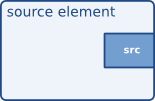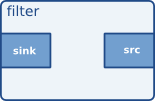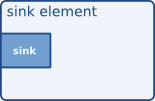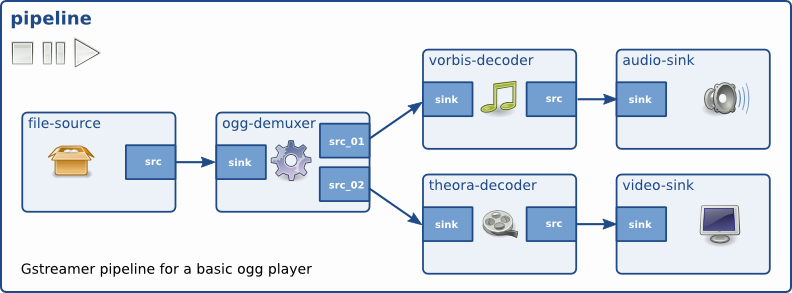官网:https://gstreamer.freedesktop.org/
Demo基础教程:hhttps://gstreamer.freedesktop.org/documentation/tutorials/basic/concepts.html
Demo下载地址:git://anongit.freedesktop.org/gstreamer/gst-docs
Goal
目标是动态创建管道,包括组件连接、消息及时获取以及组件的状态转换。
This tutorial shows the rest of the basic concepts required to use GStreamer, which allow building the pipeline "on the fly", as information becomes available, instead of having a monolithic(单一的) pipeline defined at the beginning of your application.
After this tutorial, you will have the necessary knowledge to start the Playback tutorials. The points reviewed here will be:
-
How to attain finer control when linking elements.
-
How to be notified of interesting events so you can react(反应) in time.
-
The various states in which an element can be.
Introduction
这里主要介绍衬垫(pad)的概念。source element只有source pad,sink element只有sink pad,filter element二者兼有。
As you are about to see, the pipeline in this tutorial is not completely built before it is set to the playing state. This is OK. If we did not take further action, data would reach the end of the pipeline and the pipeline would produce an error message and stop. But we are going to take further action...
In this example we are opening a file which is multiplexed (or muxed), this is, audio and video are stored together inside a container file. The elements responsible for opening such containers are called demuxers, and some examples of container formats are Matroska (MKV), Quick Time (QT, MOV), Ogg, or Advanced Systems Format (ASF, WMV, WMA).
If a container embeds multiple streams (one video and two audio tracks, for example), the demuxer will separate them and expose them through different output ports. In this way, different branches can be created in the pipeline, dealing with different types of data.
The ports through which GStreamer elements communicate with each other are called pads(衬垫) (GstPad). There exists sink pads, through which data enters an element, and source pads, through which data exits an element. It follows naturally that source elements only contain source pads, sink elements only contain sink pads, and filter elements contain both.



Figure 1. GStreamer elements with their pads.
A demuxer contains one sink pad, through which the muxed data arrives, and multiple source pads, one for each stream found in the container:

Figure 2. A demuxer with two source pads.
For completeness(完整), here you have a simplified pipeline containing a demuxer and two branches, one for audio and one for video. This is NOT the pipeline that will be built in this example:

Figure 3. Example pipeline with two branches.
只有数据正在到来的时候,才能知道需要创建多少个source pad,所以这里涉及动态创建source pad.
The main complexity when dealing with demuxers is that they cannot produce any information until they have received some data and have had a chance to look at the container to see what is inside. This is, demuxers start with no source pads to which other elements can link, and thus the pipeline must necessarily terminate at them.
The solution is to build the pipeline from the source down to the demuxer, and set it to run (play). When the demuxer has received enough information to know about the number and kind of streams in the container, it will start creating source pads. This is the right time for us to finish building the pipeline and attach it to the newly added demuxer pads.
For simplicity(简化), in this example, we will only link to the audio pad and ignore the video.
Dynamic Hello World
Copy this code into a text file named basic-tutorial-3.c (or find it in your GStreamer installation).
basic-tutorial-3.c
#include <gst/gst.h>
/* Structure to contain all our information, so we can pass it to callbacks */
typedef struct _CustomData {
GstElement *pipeline;
GstElement *source;
GstElement *convert;
GstElement *sink;
} CustomData;
/* Handler for the pad-added signal */
static void pad_added_handler (GstElement *src, GstPad *pad, CustomData *data);
int main(int argc, char *argv[]) {
CustomData data;
GstBus *bus;
GstMessage *msg;
GstStateChangeReturn ret;
gboolean terminate = FALSE;
/* Initialize GStreamer */
gst_init (&argc, &argv);
/* Create the elements */
data.source = gst_element_factory_make ("uridecodebin", "source");
data.convert = gst_element_factory_make ("audioconvert", "convert");
data.sink = gst_element_factory_make ("autoaudiosink", "sink");
/* Create the empty pipeline */
data.pipeline = gst_pipeline_new ("test-pipeline");
if (!data.pipeline || !data.source || !data.convert || !data.sink) {
g_printerr ("Not all elements could be created.\n");
return -1;
}
/* Build the pipeline. Note that we are NOT linking the source at this
* point. We will do it later. */
gst_bin_add_many (GST_BIN (data.pipeline), data.source, data.convert , data.sink, NULL);
if (!gst_element_link (data.convert, data.sink)) {
g_printerr ("Elements could not be linked.\n");
gst_object_unref (data.pipeline);
return -1;
}
/* Set the URI to play */
g_object_set (data.source, "uri", "https://www.freedesktop.org/software/gstreamer-sdk/data/media/sintel_trailer-480p.webm", NULL);
/* Connect to the pad-added signal */
g_signal_connect (data.source, "pad-added", G_CALLBACK (pad_added_handler), &data);
/* Start playing */
ret = gst_element_set_state (data.pipeline, GST_STATE_PLAYING);
if (ret == GST_STATE_CHANGE_FAILURE) {
g_printerr ("Unable to set the pipeline to the playing state.\n");
gst_object_unref (data.pipeline);
return -1;
}
/* Listen to the bus */
bus = gst_element_get_bus (data.pipeline);
do {
msg = gst_bus_timed_pop_filtered (bus, GST_CLOCK_TIME_NONE,
GST_MESSAGE_STATE_CHANGED | GST_MESSAGE_ERROR | GST_MESSAGE_EOS);
/* Parse message */
if (msg != NULL) {
GError *err;
gchar *debug_info;
switch (GST_MESSAGE_TYPE (msg)) {
case GST_MESSAGE_ERROR:
gst_message_parse_error (msg, &err, &debug_info);
g_printerr ("Error received from element %s: %s\n", GST_OBJECT_NAME (msg->src), err->message);
g_printerr ("Debugging information: %s\n", debug_info ? debug_info : "none");
g_clear_error (&err);
g_free (debug_info);
terminate = TRUE;
break;
case GST_MESSAGE_EOS:
g_print ("End-Of-Stream reached.\n");
terminate = TRUE;
break;
case GST_MESSAGE_STATE_CHANGED:
/* We are only interested in state-changed messages from the pipeline */
if (GST_MESSAGE_SRC (msg) == GST_OBJECT (data.pipeline)) {
GstState old_state, new_state, pending_state;
gst_message_parse_state_changed (msg, &old_state, &new_state, &pending_state);
g_print ("Pipeline state changed from %s to %s:\n",
gst_element_state_get_name (old_state), gst_element_state_get_name (new_state));
}
break;
default:
/* We should not reach here */
g_printerr ("Unexpected message received.\n");
break;
}
gst_message_unref (msg);
}
} while (!terminate);
/* Free resources */
gst_object_unref (bus);
gst_element_set_state (data.pipeline, GST_STATE_NULL);
gst_object_unref (data.pipeline);
return 0;
}
/* This function will be called by the pad-added signal */
static void pad_added_handler (GstElement *src, GstPad *new_pad, CustomData *data) {
GstPad *sink_pad = gst_element_get_static_pad (data->convert, "sink");
GstPadLinkReturn ret;
GstCaps *new_pad_caps = NULL;
GstStructure *new_pad_struct = NULL;
const gchar *new_pad_type = NULL;
g_print ("Received new pad '%s' from '%s':\n", GST_PAD_NAME (new_pad), GST_ELEMENT_NAME (src));
/* If our converter is already linked, we have nothing to do here */
if (gst_pad_is_linked (sink_pad)) {
g_print ("We are already linked. Ignoring.\n");
goto exit;
}
/* Check the new pad's type */
new_pad_caps = gst_pad_get_current_caps (new_pad);
new_pad_struct = gst_caps_get_structure (new_pad_caps, 0);
new_pad_type = gst_structure_get_name (new_pad_struct);
if (!g_str_has_prefix (new_pad_type, "audio/x-raw")) {
g_print ("It has type '%s' which is not raw audio. Ignoring.\n", new_pad_type);
goto exit;
}
/* Attempt the link */
ret = gst_pad_link (new_pad, sink_pad);
if (GST_PAD_LINK_FAILED (ret)) {
g_print ("Type is '%s' but link failed.\n", new_pad_type);
} else {
g_print ("Link succeeded (type '%s').\n", new_pad_type);
}
exit:
/* Unreference the new pad's caps, if we got them */
if (new_pad_caps != NULL)
gst_caps_unref (new_pad_caps);
/* Unreference the sink pad */
gst_object_unref (sink_pad);
}
Walkthrough
封装一个结构体,为了方便将来在回调中设置。
/* Structure to contain all our information, so we can pass it to callbacks */
typedef struct _CustomData {
GstElement *pipeline;
GstElement *source;
GstElement *convert;
GstElement *sink;
} CustomData;
So far we have kept all the information we needed (pointers to GstElements, basically) as local variables. Since this tutorial (and most real applications) involves callbacks, we will group all our data in a structure for easier handling.
下边这个接口是设置回调,稍后介绍。
/* Handler for the pad-added signal */
static void pad_added_handler (GstElement *src, GstPad *pad, CustomData *data);
This is a forward reference, to be used later.
/* Create the elements */
data.source = gst_element_factory_make ("uridecodebin", "source");
data.convert = gst_element_factory_make ("audioconvert", "convert");
data.sink = gst_element_factory_make ("autoaudiosink", "sink");
uridecodebin 类型会内部初始化必要的element,从uri地址中分离出音视频。audioconvert 是一个音频转换器,使音频转化为标准音频。autoaudiosink 是一个音频接收器,播放出声音。
We create the elements as usual. uridecodebin will internally instantiate(内部实例化) all the necessary elements (sources, demuxers and decoders) to turn a URI into raw audio and/or video streams. It does half the work that playbin does. Since it contains demuxers, its source pads are not initially(开头) available and we will need to link to them on the fly.
audioconvert is useful for converting between different audio formats, making sure that this example will work on any platform, since the format produced by the audio decoder might not be the same that the audio sink expects.
The autoaudiosink is the equivalent(相当于) of autovideosink seen in the previous tutorial, for audio. It will render the audio stream to the audio card.
将convert和sink连接起来,这二个element已经确定,source element还没有确定,需要分离器从uri中分离出来后再进行连接。
if (!gst_element_link (data.convert, data.sink)) {
g_printerr ("Elements could not be linked.\n");
gst_object_unref (data.pipeline);
return -1;
}
Here we link the converter element to the sink, but we DO NOT link them with the source, since at this point it contains no source pads. We just leave this branch (converter + sink) unlinked, until later on.
/* Set the URI to play */
g_object_set (data.source, "uri", "https://www.freedesktop.org/software/gstreamer-sdk/data/media/sintel_trailer-480p.webm", NULL);
We set the URI of the file to play via a property, just like we did in the previous tutorial.给source element设置uri地址。
Signals
/* Connect to the pad-added signal */
g_signal_connect (data.source, "pad-added", G_CALLBACK (pad_added_handler), &data);
我们可以对指定的element元素添加一个信号,当element有信号是,会触发我们设置的回调pad_added_handler,通知我们去处理。第二个参数pad_added是一个信号名称(表示有pad产生)。信号名称可以通过对应elemnt的文档或者通过工具gst-inspect-1.0获取。
GSignals are a crucial(重要的) point in GStreamer. They allow you to be notified (by means of a callback) when something interesting has happened. Signals are identified by a name, and each GObject has its own signals.
In this line, we are attaching to the “pad-added” signal of our source (an uridecodebin element). To do so, we use g_signal_connect() and provide the callback function to be used (pad_added_handler) and a data pointer. GStreamer does nothing with this data pointer, it just forwards it to the callback so we can share information with it. In this case, we pass a pointer to the CustomData structure we built specially for this purpose.
The signals that a GstElement generates can be found in its documentation or using the gst-inspect-1.0 tool as described in Basic tutorial 10: GStreamer tools.
We are now ready to go! Just set the pipeline to the PLAYING state and start listening to the bus for interesting messages (like ERROR or EOS), just like in the previous tutorials.
The callback
当uridecodebin类型的element分理处音视频数据的时候,就会触发pad_added_handler回调,这个回调有三个参数,第一个参数就是产生这个回调的element,第二个参数,是新增的pad,第三个参数是之前设置的上下文。
When our source element finally has enough information to start producing data, it will create source pads, and trigger the “pad-added” signal. At this point our callback will be called:
static void pad_added_handler (GstElement *src, GstPad *new_pad, CustomData *data) {
src is the GstElement which triggered the signal. In this example, it can only be the uridecodebin, since it is the only signal to which we have attached. The first parameter of a signal handler is always the object that has triggered it.
new_pad is the GstPad that has just been added to the src element. This is usually the pad to which we want to link.
data is the pointer we provided when attaching to the signal. In this example, we use it to pass the CustomDatapointer.
通过上下文以及gst_element_get_static_pad 函数,可以获取convert这个element的sinkpad,这里我们需要将我们source pad和sink pad连接起来,和之前介绍的element直接连接一样。可以通过函数gst_pad_is_linked判断一个pad是否已经连接。
GstPad *sink_pad = gst_element_get_static_pad (data->convert, "sink");
From CustomData we extract the converter element, and then retrieve its sink pad using gst_element_get_static_pad (). This is the pad to which we want to link new_pad. In the previous tutorial we linked element against element, and let GStreamer choose the appropriate pads. Now we are going to link the pads directly.
/* If our converter is already linked, we have nothing to do here */
if (gst_pad_is_linked (sink_pad)) {
g_print ("We are already linked. Ignoring.\n");
goto exit;
}
可以通过new_pad_caps = gst_pad_get_current_caps,gst_caps_get_structure,gst_structure_get_name获取pad的名称,通过名称可以过滤是否是关心的pad。uridecodebin can create as many pads as it sees fit, and for each one, this callback will be called. These lines of code will prevent us from trying to link to a new pad once we are already linked.
/* Check the new pad's type */
new_pad_caps = gst_pad_get_current_caps (new_pad, NULL);
new_pad_struct = gst_caps_get_structure (new_pad_caps, 0);
new_pad_type = gst_structure_get_name (new_pad_struct);
if (!g_str_has_prefix (new_pad_type, "audio/x-raw")) {
g_print ("It has type '%s' which is not raw audio. Ignoring.\n", new_pad_type);
goto exit;
}
Now we will check the type of data this new pad is going to output, because we are only interested in pads producing audio. We have previously created a piece of pipeline which deals with audio (an audioconvert linked with an autoaudiosink), and we will not be able to link it to a pad producing video, for example.
gst_pad_get_current_caps() retrieves the current capabilities of the pad (that is, the kind of data it currently outputs), wrapped in a GstCaps structure. All possible caps a pad can support can be queried withgst_pad_query_caps(). A pad can offer many capabilities, and hence GstCaps can contain many GstStructure, each representing a different capability. The current caps on a pad will always have a single GstStructure and represent a single media format, or if there are no current caps yet NULL will be returned.
Since, in this case, we know that the pad we want only had one capability (audio), we retrieve the first GstStructure with gst_caps_get_structure().
Finally, with gst_structure_get_name() we recover the name of the structure, which contains the main description of the format (its media type, actually).
If the name is not audio/x-raw, this is not a decoded audio pad, and we are not interested in it.
Otherwise, attempt the link:可以通过gst_pad_link将两个合适的pad进行连接(当然前提是在同一个bin里)。
/* Attempt the link */
ret = gst_pad_link (new_pad, sink_pad);
if (GST_PAD_LINK_FAILED (ret)) {
g_print ("Type is '%s' but link failed.\n", new_pad_type);
} else {
g_print ("Link succeeded (type '%s').\n", new_pad_type);
}
gst_pad_link() tries to link two pads. As it was the case with gst_element_link(), the link must be specified from source to sink, and both pads must be owned by elements residing in(位于0 the same bin (or pipeline).
And we are done! When a pad of the right kind appears, it will be linked to the rest of the audio-processing pipeline and execution will continue until ERROR or EOS. However, we will squeeze(榨取,获得) a bit more content from this tutorial by also introducing the concept of State.
GStreamer States
We already talked a bit about states when we said that playback does not start until you bring the pipeline to the PLAYING state. We will introduce here the rest of states and their meaning. There are 4 states in GStreamer:
| State | Description |
|-----------|--------------------|
| `NULL` | the NULL state or initial state of an element. |
| `READY` | the element is ready to go to PAUSED. |
| `PAUSED` | the element is PAUSED, it is ready to accept and process data. Sink elements however only accept one buffer and then block. |
| `PLAYING` | the element is PLAYING, the clock is running and the data is flowing. |
You can only move between adjacent(相邻的) ones, this is, you can't go from NULL to PLAYING, you have to go through the intermediate READY and PAUSED states. If you set the pipeline to PLAYING, though, GStreamer will make the intermediate(中间的) transitions for you.
case GST_MESSAGE_STATE_CHANGED:
/* We are only interested in state-changed messages from the pipeline */
if (GST_MESSAGE_SRC (msg) == GST_OBJECT (data.pipeline)) {
GstState old_state, new_state, pending_state;
gst_message_parse_state_changed (msg, &old_state, &new_state, &pending_state);
g_print ("Pipeline state changed from %s to %s:\n",
gst_element_state_get_name (old_state), gst_element_state_get_name (new_state));
}
break;
We added this piece of code that listens to bus messages regarding state changes and prints them on screen to help you understand the transitions. Every element puts messages on the bus regarding its current state, so we filter them out and only listen to messages coming from the pipeline.
Most applications only need to worry about going to PLAYING to start playback, then to PAUSED to perform a pause, and then back to NULL at program exit to free all resources.
Exercise
Dynamic pad linking has traditionally been a difficult topic for a lot of programmers. Prove that you have achieved its mastery by instantiating an autovideosink (probably with an videoconvert in front) and link it to the demuxer when the right pad appears. Hint: You are already printing on screen the type of the video pads.
You should now see (and hear) the same movie as in Basic tutorial 1: Hello world!. In that tutorial you used playbin, which is a handy element that automatically takes care of all the demuxing and pad linking for you. Most of the Playback tutorials are devoted to playbin.
Conclusion
In this tutorial, you learned:
- How to be notified of events using
GSignals - How to connect
GstPads directly instead of their parent elements. - The various states of a GStreamer element.
You also combined these items to build a dynamic pipeline, which was not defined at program start, but was created as information regarding the media was available.
You can now continue with the basic tutorials and learn about performing seeks and time-related queries in Basic tutorial 4: Time management or move to the Playback tutorials, and gain more insight about the playbin element.
Remember that attached to this page you should find the complete source code of the tutorial and any accessory files needed to build it. It has been a pleasure having you here, and see you soon!